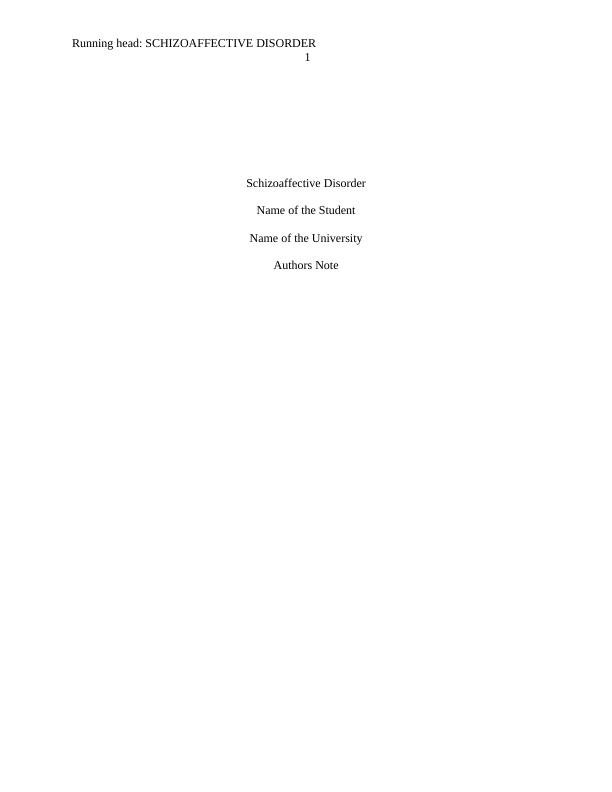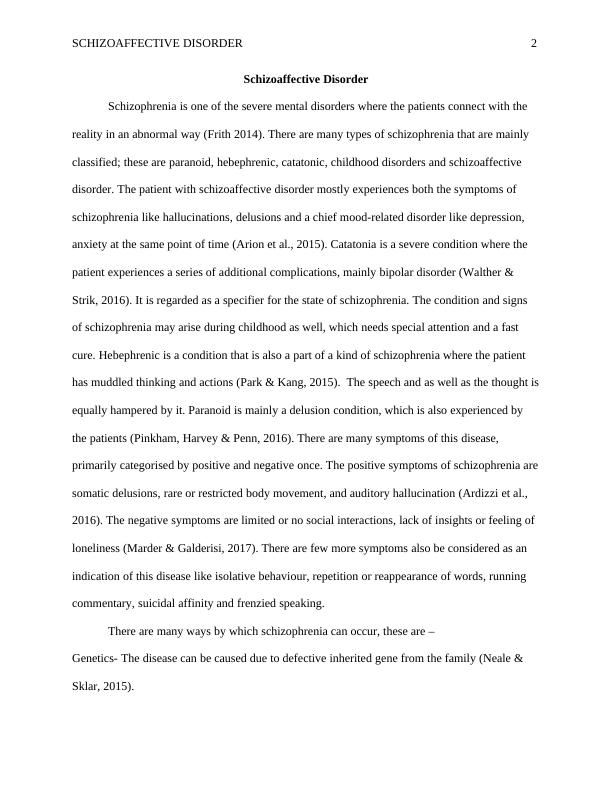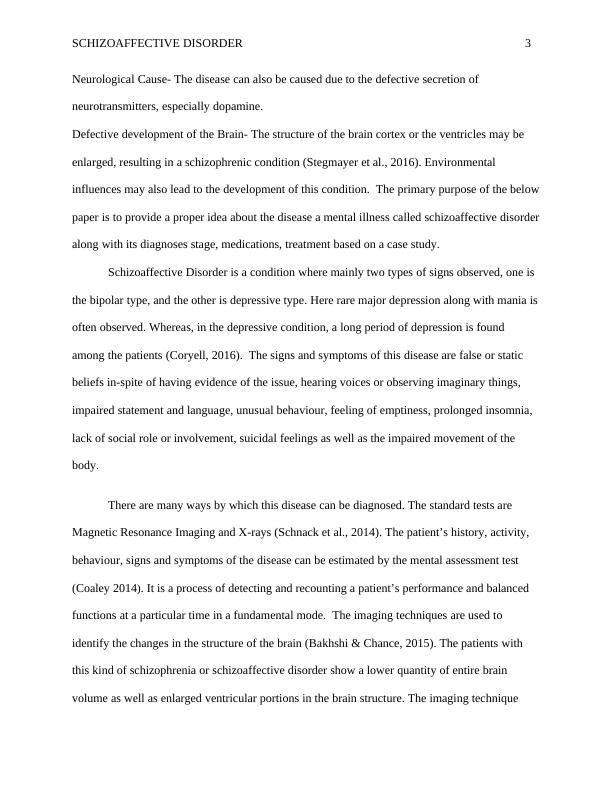Schizoaffective Disorder Schizophrenia
Added on 2022-08-11
13 Pages4531 Words28 Views
Running head: SCHIZOAFFECTIVE DISORDER
1
Schizoaffective Disorder
Name of the Student
Name of the University
Authors Note
1
Schizoaffective Disorder
Name of the Student
Name of the University
Authors Note

SCHIZOAFFECTIVE DISORDER 2
Schizoaffective Disorder
Schizophrenia is one of the severe mental disorders where the patients connect with the
reality in an abnormal way (Frith 2014). There are many types of schizophrenia that are mainly
classified; these are paranoid, hebephrenic, catatonic, childhood disorders and schizoaffective
disorder. The patient with schizoaffective disorder mostly experiences both the symptoms of
schizophrenia like hallucinations, delusions and a chief mood-related disorder like depression,
anxiety at the same point of time (Arion et al., 2015). Catatonia is a severe condition where the
patient experiences a series of additional complications, mainly bipolar disorder (Walther &
Strik, 2016). It is regarded as a specifier for the state of schizophrenia. The condition and signs
of schizophrenia may arise during childhood as well, which needs special attention and a fast
cure. Hebephrenic is a condition that is also a part of a kind of schizophrenia where the patient
has muddled thinking and actions (Park & Kang, 2015). The speech and as well as the thought is
equally hampered by it. Paranoid is mainly a delusion condition, which is also experienced by
the patients (Pinkham, Harvey & Penn, 2016). There are many symptoms of this disease,
primarily categorised by positive and negative once. The positive symptoms of schizophrenia are
somatic delusions, rare or restricted body movement, and auditory hallucination (Ardizzi et al.,
2016). The negative symptoms are limited or no social interactions, lack of insights or feeling of
loneliness (Marder & Galderisi, 2017). There are few more symptoms also be considered as an
indication of this disease like isolative behaviour, repetition or reappearance of words, running
commentary, suicidal affinity and frenzied speaking.
There are many ways by which schizophrenia can occur, these are –
Genetics- The disease can be caused due to defective inherited gene from the family (Neale &
Sklar, 2015).
Schizoaffective Disorder
Schizophrenia is one of the severe mental disorders where the patients connect with the
reality in an abnormal way (Frith 2014). There are many types of schizophrenia that are mainly
classified; these are paranoid, hebephrenic, catatonic, childhood disorders and schizoaffective
disorder. The patient with schizoaffective disorder mostly experiences both the symptoms of
schizophrenia like hallucinations, delusions and a chief mood-related disorder like depression,
anxiety at the same point of time (Arion et al., 2015). Catatonia is a severe condition where the
patient experiences a series of additional complications, mainly bipolar disorder (Walther &
Strik, 2016). It is regarded as a specifier for the state of schizophrenia. The condition and signs
of schizophrenia may arise during childhood as well, which needs special attention and a fast
cure. Hebephrenic is a condition that is also a part of a kind of schizophrenia where the patient
has muddled thinking and actions (Park & Kang, 2015). The speech and as well as the thought is
equally hampered by it. Paranoid is mainly a delusion condition, which is also experienced by
the patients (Pinkham, Harvey & Penn, 2016). There are many symptoms of this disease,
primarily categorised by positive and negative once. The positive symptoms of schizophrenia are
somatic delusions, rare or restricted body movement, and auditory hallucination (Ardizzi et al.,
2016). The negative symptoms are limited or no social interactions, lack of insights or feeling of
loneliness (Marder & Galderisi, 2017). There are few more symptoms also be considered as an
indication of this disease like isolative behaviour, repetition or reappearance of words, running
commentary, suicidal affinity and frenzied speaking.
There are many ways by which schizophrenia can occur, these are –
Genetics- The disease can be caused due to defective inherited gene from the family (Neale &
Sklar, 2015).

SCHIZOAFFECTIVE DISORDER 3
Neurological Cause- The disease can also be caused due to the defective secretion of
neurotransmitters, especially dopamine.
Defective development of the Brain- The structure of the brain cortex or the ventricles may be
enlarged, resulting in a schizophrenic condition (Stegmayer et al., 2016). Environmental
influences may also lead to the development of this condition. The primary purpose of the below
paper is to provide a proper idea about the disease a mental illness called schizoaffective disorder
along with its diagnoses stage, medications, treatment based on a case study.
Schizoaffective Disorder is a condition where mainly two types of signs observed, one is
the bipolar type, and the other is depressive type. Here rare major depression along with mania is
often observed. Whereas, in the depressive condition, a long period of depression is found
among the patients (Coryell, 2016). The signs and symptoms of this disease are false or static
beliefs in-spite of having evidence of the issue, hearing voices or observing imaginary things,
impaired statement and language, unusual behaviour, feeling of emptiness, prolonged insomnia,
lack of social role or involvement, suicidal feelings as well as the impaired movement of the
body.
There are many ways by which this disease can be diagnosed. The standard tests are
Magnetic Resonance Imaging and X-rays (Schnack et al., 2014). The patient’s history, activity,
behaviour, signs and symptoms of the disease can be estimated by the mental assessment test
(Coaley 2014). It is a process of detecting and recounting a patient’s performance and balanced
functions at a particular time in a fundamental mode. The imaging techniques are used to
identify the changes in the structure of the brain (Bakhshi & Chance, 2015). The patients with
this kind of schizophrenia or schizoaffective disorder show a lower quantity of entire brain
volume as well as enlarged ventricular portions in the brain structure. The imaging technique
Neurological Cause- The disease can also be caused due to the defective secretion of
neurotransmitters, especially dopamine.
Defective development of the Brain- The structure of the brain cortex or the ventricles may be
enlarged, resulting in a schizophrenic condition (Stegmayer et al., 2016). Environmental
influences may also lead to the development of this condition. The primary purpose of the below
paper is to provide a proper idea about the disease a mental illness called schizoaffective disorder
along with its diagnoses stage, medications, treatment based on a case study.
Schizoaffective Disorder is a condition where mainly two types of signs observed, one is
the bipolar type, and the other is depressive type. Here rare major depression along with mania is
often observed. Whereas, in the depressive condition, a long period of depression is found
among the patients (Coryell, 2016). The signs and symptoms of this disease are false or static
beliefs in-spite of having evidence of the issue, hearing voices or observing imaginary things,
impaired statement and language, unusual behaviour, feeling of emptiness, prolonged insomnia,
lack of social role or involvement, suicidal feelings as well as the impaired movement of the
body.
There are many ways by which this disease can be diagnosed. The standard tests are
Magnetic Resonance Imaging and X-rays (Schnack et al., 2014). The patient’s history, activity,
behaviour, signs and symptoms of the disease can be estimated by the mental assessment test
(Coaley 2014). It is a process of detecting and recounting a patient’s performance and balanced
functions at a particular time in a fundamental mode. The imaging techniques are used to
identify the changes in the structure of the brain (Bakhshi & Chance, 2015). The patients with
this kind of schizophrenia or schizoaffective disorder show a lower quantity of entire brain
volume as well as enlarged ventricular portions in the brain structure. The imaging technique

SCHIZOAFFECTIVE DISORDER 4
also reveals about the variations in the zones of the hippocampal and thalamic proportions and a
sudden increase in the quantity of Globus pallidus, the changes in the grey matter of the brain is
also observed among the patients with schizoaffective disorder (Amann et al., 2016). All these
are kinds of physiological changes observed among the patient who has this disease. The tests
are useful as it provides complete structural and functional evidence about the patients’ health.
There are two critical central states among the patients with the schizoaffective disorder; these
are mood and affect. Mood is a kind of fundamental emotional sensation resulting from a fixed
stimulus, whereas affect is the manifestation of the feeling, which refers to the state of mind
(Chui et al., 2016). The mood is generally challenging to determine but affect is always visible.
Mood is usually recognized by anger, depression, irritations.
The case study is based on an adult. The patient was varieties of symptoms of blocking
thoughts, auditory hallucinations, lack of friends and social involvements, ability to know future,
perceptual troubles; she could also hear voices advising directions, along with that the patient
also faces suicidal thoughts when in pressure or stressed, some other symptoms of the patient
was a mixed episode of feelings like manic, insomnia, hyper-impulsive (Arion et al., 2015. The
patient also reduced her interaction with society, and due to this left her job. The patient was also
experiencing manic symptoms like mood swings, impulsivity, and grandiosity. After her
admission in the hospital and after observing her, it was found that she was having poor sitting
posture, high-pitched voice, a bit of thought blocking process was also there. The suicidal
symptoms was also reduced, but she still hears the voices like before.
The patient was having the symptoms of schizoaffective disorder, which combine both
mood disorder, along with the signs of schizophrenia (Wilson, Nian & Heckers, 2014). The
symbols such as auditory hallucination, mood affect, mania, sleep disorders, defective body
also reveals about the variations in the zones of the hippocampal and thalamic proportions and a
sudden increase in the quantity of Globus pallidus, the changes in the grey matter of the brain is
also observed among the patients with schizoaffective disorder (Amann et al., 2016). All these
are kinds of physiological changes observed among the patient who has this disease. The tests
are useful as it provides complete structural and functional evidence about the patients’ health.
There are two critical central states among the patients with the schizoaffective disorder; these
are mood and affect. Mood is a kind of fundamental emotional sensation resulting from a fixed
stimulus, whereas affect is the manifestation of the feeling, which refers to the state of mind
(Chui et al., 2016). The mood is generally challenging to determine but affect is always visible.
Mood is usually recognized by anger, depression, irritations.
The case study is based on an adult. The patient was varieties of symptoms of blocking
thoughts, auditory hallucinations, lack of friends and social involvements, ability to know future,
perceptual troubles; she could also hear voices advising directions, along with that the patient
also faces suicidal thoughts when in pressure or stressed, some other symptoms of the patient
was a mixed episode of feelings like manic, insomnia, hyper-impulsive (Arion et al., 2015. The
patient also reduced her interaction with society, and due to this left her job. The patient was also
experiencing manic symptoms like mood swings, impulsivity, and grandiosity. After her
admission in the hospital and after observing her, it was found that she was having poor sitting
posture, high-pitched voice, a bit of thought blocking process was also there. The suicidal
symptoms was also reduced, but she still hears the voices like before.
The patient was having the symptoms of schizoaffective disorder, which combine both
mood disorder, along with the signs of schizophrenia (Wilson, Nian & Heckers, 2014). The
symbols such as auditory hallucination, mood affect, mania, sleep disorders, defective body

End of preview
Want to access all the pages? Upload your documents or become a member.
Related Documents
Schizophrenia and Atypical Antipsychotics | Reportlg...
|12
|2842
|22
Essay on Schizoaffective disorderlg...
|13
|3401
|196
Schizoaffective Disorder Case Studylg...
|12
|3126
|29
Literature Review on Schizophrenialg...
|12
|2810
|370
Schizophrenia: Causes, Symptoms, and Recoverylg...
|5
|1095
|60
Schizophrenia: Eric's Case Studylg...
|7
|1604
|108
